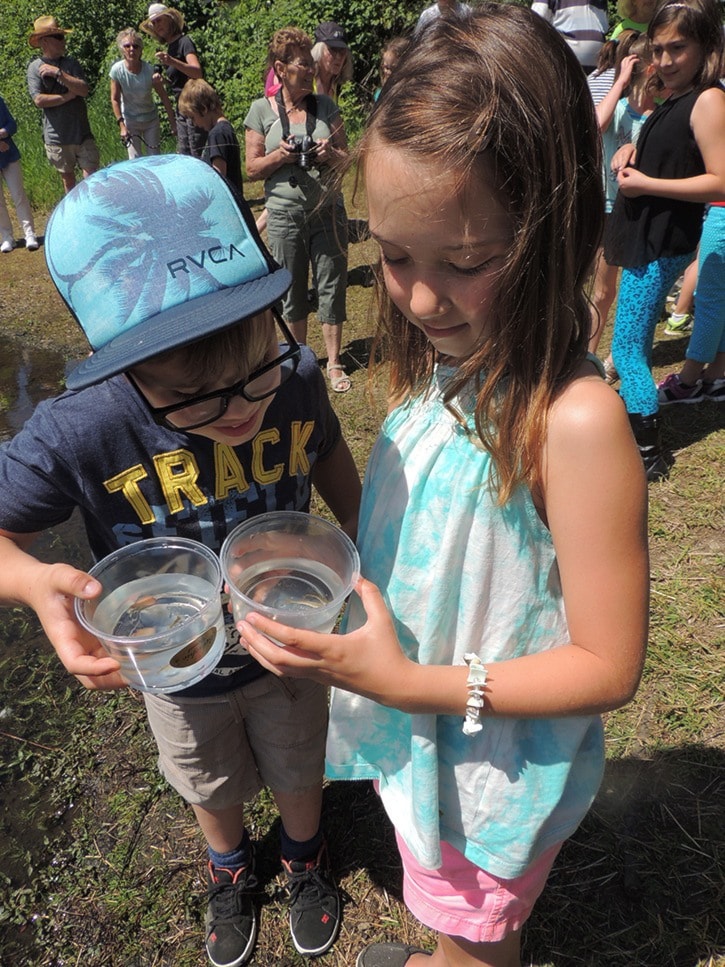Beb, Zippy and Jackie Chan Jr. wiggle their way into the water amidst cheers. Students gleefully watch as the small Coho fry leave the plastic buckets held cautiously in kids' hands out into the watery depths of the Miami River.
Tuesday afternoon saw the end result of three and a half months of hard work by students in Mr. Emsley's grade 2/ 3 class at Harrison Hot Springs Elementary School. Thanks to a partnership with the Miami River Streamkeepers Society, they were able to raise a batch of coho fry from eggs right in their classroom.
Lille, 8 years old and in grade 2, holds a bucket with 'Chicken' inside. How can she tell it's him?
"See that," she asks, peering into the bucket. "See how he acts all crazy and wiggles? That's how I know that's Chicken."
The 20 students have been absorbed in the world of salmon for the last three and a half months, watching the fish and keeping a close eye on their living conditions. Teacher Melanie Emsley says the students learned a great deal through the project. They learned how to care for an animal, from cleaning the tank to proper nutrition. They took temperature readings as well as daily PH and nitrate testing. Emsley says math was a huge part of the learning, explaining how the students even learned how to calculate the day the salmon could be released. They also learned a great deal about science, local First Nations history and more. Students took initiative in each step of the fish's development and took pride in ensuring their measurements were accurate.
More than the math or science though, Emsley says it brought out an enthusiasm out in some students that was wonderful to watch.
"It was motivating in the morning - they'd come in and be so excited," shares Emsley. "Some kids have a hard time in the morning. But they would come straight in, not even say hi to me and go check the temperature."
Emsley is glad her class was able to do the project and hopes to do it again next year, adding it is a wonderful partnership between the school and the Miami River Streemkeepers society.
"Kids are suffering from not engaging in the outdoors," she says. "There's a gap there. They don't understand and appreciate where their food comes from."
When asked questions about their lifecycle, eating habits and growth, students confidently answered, sharing their wealth of knowledge without even realizing how much they now know about this important species.
Caleb, a grade 3 student in the class, talks about the stages of food the fish needed to be fed, and how it was important to keep the chiller from touching the glass.
"I never knew that some salmon are, like, all different," said Caleb. "Some are small, some are big."
Grade 2 student Reece liked learning about the memory of a salmon.
They can remember where they were born from their egg," he says.
He, like the other students, got to take part in helping to feed the fish and was also one of the lucky students to get to clean the tank. Now that the fish have been released, Reece says he knows they will stay in the Miami River a little while, then go to the ocean, then come back within about four years.
While the education was solid and the students learned a great deal, they are most giddy to share the creative names they gave to their pseudo-pets. Skittles, Farkles and Bacon are three of the 42 fish released in the slough. The class started with 55 eggs. Emsley says her students did well in keeping 42 alive. Other classes in the Fraser Valley have done this project and lost most or even all of the fish before they were ready to be released.
The salmon program was one of the projects funded through a grant the streamkeepers received from the Pacific Salmon Foundation / Community Salmon Program last year. The $6,534 funded the cooling unit for the salmon as well as 782 native plants for the Miami River greenway riparian strip, treatment of invasive Japanese knotweed plant, installation of three interpretive signs and the purchase of tools. Adding in the volunteer time spent on these projects brought the $6,500 grant to a $30,000 value, estimates Janne Perrin of the streamkeepers society.
Other major partners for the projects included the Village of Harrison Hot Springs, the Fraser Valley Invasive Plant Council, the Fraser Valley Watersheds Coalition and the former Harrison Hot Springs Communities in Bloom committee.
The Miami River Streamkeepers society is a local volunteer organization whose vision is to restore the Miami River through an ongoing revitalization program. Janne Perrin invites anyone interested to join them for a weekly walk and weed, every Monday, weather dependent, except holidays. They meet at 327 Miami River Drive at 10 a.m. To learn more about the group, see http://miamiriverstreamkeepers.ca
